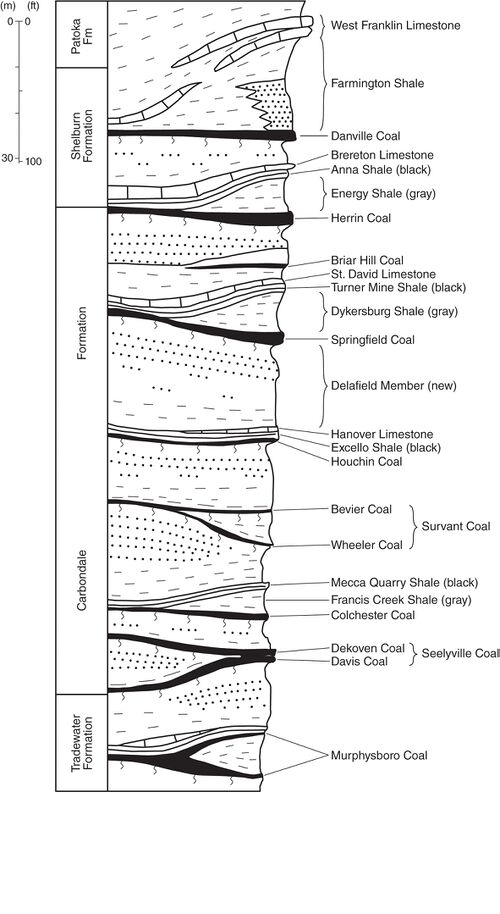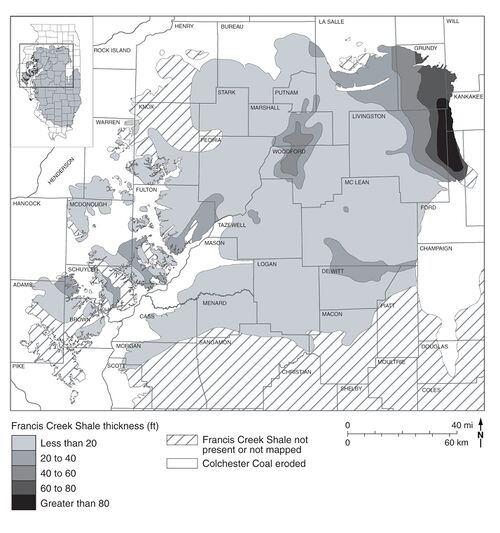Galatia Channel:Colchester Coal and Francis Creek Shale
Colchester Coal and Francis Creek Shale
The Colchester Coal may be the most extensive coal bed in North America, if not the world (Wanless 1975[1]; Greb et al. 2003[2]). It correlates with the Lower Kittanning coal bed of the northern Appalachians and the Croweburg Coal of the Western Interior. Cecil et al. (2003b)[3] characterized time-equivalent rocks throughout the continental United States.
In most of the Illinois Basin, the Colchester is too thin to mine (≤1.6 ft [≤0.5 m]) and is directly overlain by the black, phosphatic Mecca Quarry Shale, with the marine Oak Grove Limestone above that (Figure 40). In northern Illinois, the coal thickens to as much as 4.6 ft (1.4 m) and is overlain by the gray Francis Creek Shale, which ranges up to 34 m (112 ft) thick (Figure 41). Low-sulfur Colchester Coal is known from only two mines among the hundreds that formerly worked this seam. These mines had thick Francis Creek; however, many other mines having thick Francis Creek had high-sulfur coal (Gluskoter and Hopkins 1970)[4].
The Francis Creek and Dykersburg Shales are closely similar in some respects and different in others. Both units encapsulate upright tree stumps and display beautifully developed tidal rhythmites (Kuecher et al. 1990[5]; Baird 1997[6]). The Francis Creek shows a more consistent upward-coarsening profile than the Dykersburg. The upper part includes rooted zones, impure coal, channel-form sandstone bodies, and features interpreted as crevasse splays and natural levees (Baird 1997)[6]. Most notably, the Francis Creek bears the famous Mazon Creek fossils, preserved in siderite concretions. These include a remarkable fauna of soft-bodied organisms, some known nowhere else (Shabica and Hay 1997)[7], along with a rich and diverse flora of land plants (Wittry 2006)[8]. These fossils have been divided into a “Braidwood assemblage” representing fresh to slightly brackish, tidally influenced water and an “Essex assemblage” of more saline but not fully marine conditions (Baird 1997)[6]. The Braidwood assemblage and thickest Francis Creek Shale are localized near the northeastern margin of the basin. The Dykersburg lacks a significant invertebrate fauna, and a marine to brackish transition has yet to be defined.
All these features point to extremely rapid sedimentation, at least locally. By counting tidal cycles and measuring their thickness, Kuecher et al. (1990)[5] determined rates as rapid as 3.3 ft (1 m) per year.
No “split” Colchester Coal or channels contemporaneous with the coal have been identified. However, patterns of Francis Creek Shale distribution and enclosed biota suggest that river mouths lay a short distance northeast of the present Colchester outcrop (Baird et al. 1985a)[9].
As with the Dykersburg Shale, early models placed the Francis Creek in a deltaic setting (Wright 1965[10]; Shabica 1970[11]). Later authors recognized an estuarine component and favored deposition during transgression of the peat-forming lowland (Baird et al. 1985a[9], 1985b[12]).
Archer and Kvale (1993)[13] and Archer et al. (1995)[14] further emphasized the tidal, estuarine aspect. We regard the Francis Creek as a series of tidally dominated deltas that accumulated in a broad, brackish embayment.
Primary Source
References
- ↑ Wanless, H.R., 1975, Distribution of coals in the United States: U.S. Geological Survey, Professional Paper 853, p. 33–47.
- ↑ Greb, S.F., W.M. Andrews, C.F. Eble, W.A. DiMichele, C.B. Cecil, and J.C. Hower, 2003, Desmoinesian coal beds of the Eastern Interior and surrounding basins: The largest tropical peat mires in Earth history: Geological Society of America, Special Paper 370, p. 127–150.
- ↑ Cecil, C.B., F.T., Dulong, R.R. West, R. Stamm, B. Wardlaw, and N.T. Edgar, 2003b, Climate controls on the stratigraphy of a Middle Pennsylvanian cyclothem in North America, in C.B. Cecil and N.T. Edgar, eds., Climate controls on stratigraphy: SEPM (Society for Sedimentary Geology) Special Publication 77, p. 151–180, https://doi.org/10.2110/pec.03.77.0151.
- ↑ Gluskoter, H.J., and M.E. Hopkins, 1970, Distribution of sulfur in Illinois coals: Illinois State Geological Survey, Guidebook Series 8, p. 89–95.
- ↑ a b Kuecher, G.J., B.G. Woodland, and F.M. Broadhurst, 1990, Evidence of deposition from individual tides and of tidal cycles from the Francis Creek Shale Member (host rock to the Mazon Creek biota), Westphalian D (Pennsylvanian), northeastern Illinois: Sedimentary Geology, v. 68, p. 211–221.
- ↑ a b c Baird, G.C., 1997, Paleoenvironmental setting of the Mazon Creek biota, in C.W. Shabica and A.A. Hay, eds., Richardson’s guide to the fossil fauna of Mazon Creek: Chicago, Northeastern Illinois University, p. 35–51.
- ↑ Shabica, C.W., and A.A. Hay, eds., 1997, Richardson’s guide to the fossil fauna of Mazon Creek: Chicago, Northeastern Illinois University, 308 p.
- ↑ Wittry, J., 2006, The Mazon Creek fossil flora: Downers Grove, Earth Science Club of Northern Illinois (ESCONI), 154 p.
- ↑ a b Baird, G.C., C.W. Shabica, J.L. Anderson, and E.S. Richardson, 1985a, Biota of a Pennsylvanian muddy coast: Habitats within the Mazonian delta complex, northeast Illinois: Journal of Paleontology, v. 59, no. 2, p. 253–281.
- ↑ Wright, C.R., 1965, Environmental mapping of the beds of the Liverpool cyclothem in the Illinois Basin and equivalent strata in the northern midcontinent region: Urbana, University of Illinois, Ph.D. thesis, 100 p.
- ↑ Shabica, C.W., 1970, Depositional environments in the Francis Creek Shale: Illinois State Geological Survey, Guidebook Series 8, p. 43–52.
- ↑ Baird, G.C., S.D. Sroka, C.W. Shabica, and T.L. Beard, 1985b, Mazon-Creek-type fossil assemblages in the U.S. Midcontinent Pennsylvanian: Their recurrent character and palaeoenvironmental significance: Philosophical Transactions of the Royal Society, London, v. 311, p. 87–99.
- ↑ Archer, A.W., and E.P. Kvale, 1993, Origin of gray shale lithofacies (clastic wedges) in U.S. Midcontinent coal measures (Pennsylvanian): An alternate explanation: Geological Society of America, Special Paper 286, p. 181–192.
- ↑ Archer, A.W., G.J. Kuecher, and E.P. Kvale, 1995, The role of tidal-velocity asymmetries in the deposition of silty tidal rhythmites (Carboniferous, Eastern Interior Coal Basin, U.S.A.): Journal of Sedimentary Research, v. 65A, p. 408–416.

